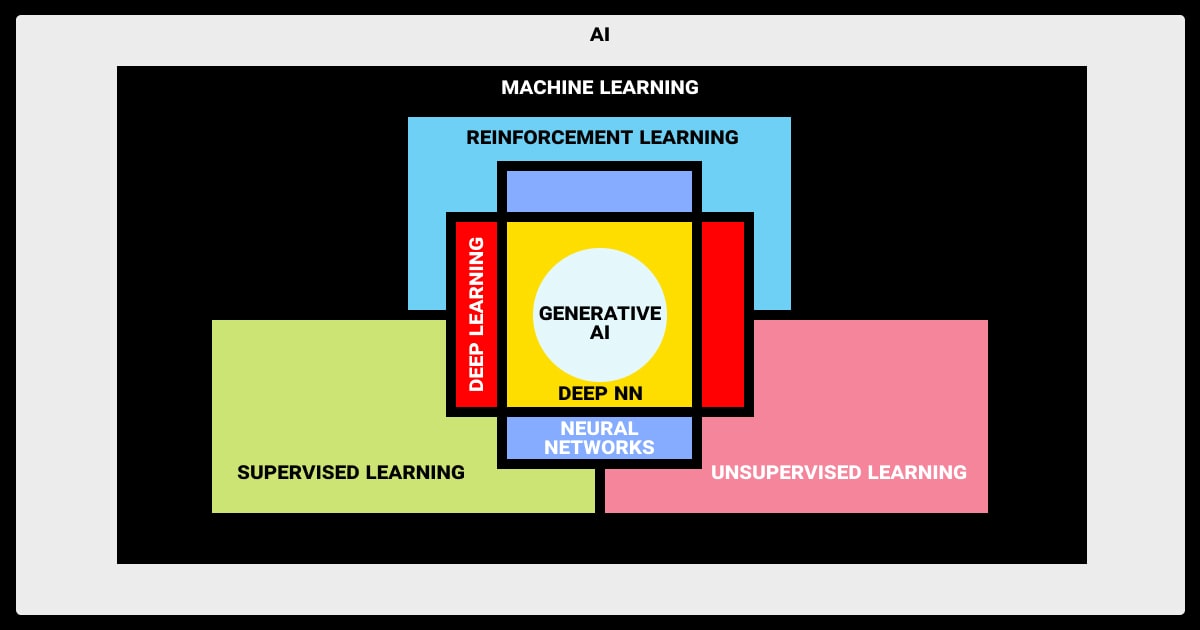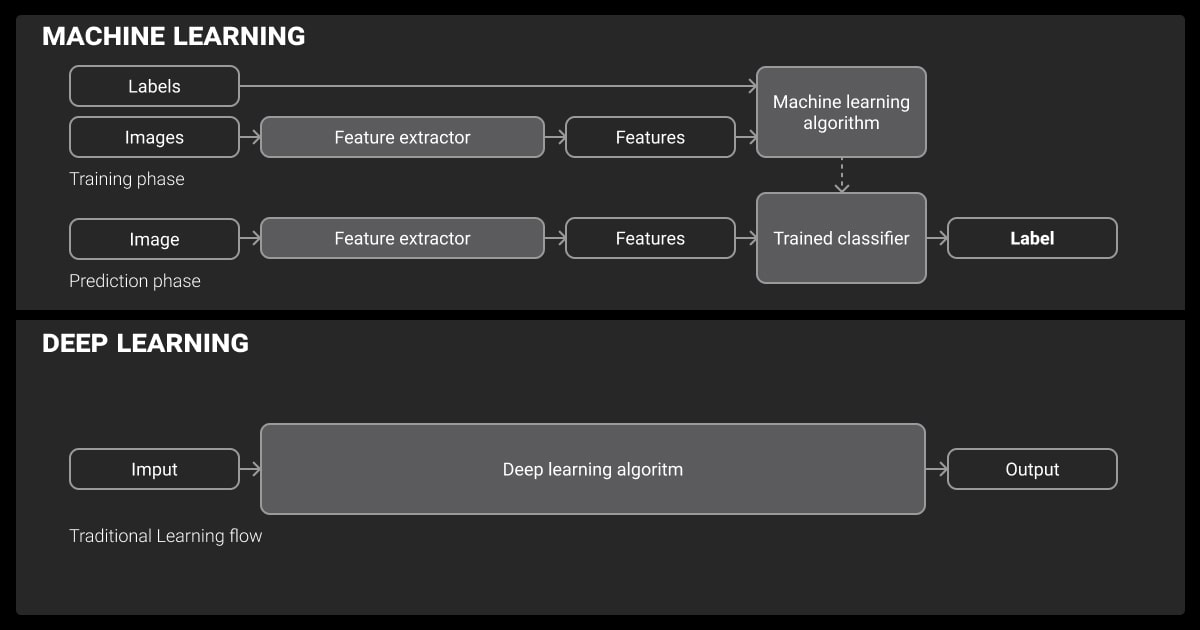Deep Learning vs Machine Learning: Key Differences
Table of Contents
- TL;DR
- The AI Hierarchy: AI > Machine Learning > Deep Learning
- What Is Machine Learning?
- What Is Deep Learning?
- Deep Learning vs Machine Learning: Core Differences That Matter
- When to Use Machine Learning
- When to Use Deep Learning
- Bridging Deep Learning vs Machine Learning in Real-World Pipelines
- Evaluating Deep Learning vs Machine Learning Models
- Real-World Applications of Deep Learning vs Machine Learning
- Deep Learning vs Machine Learning: Choosing the Right Approach
- Ethical and Operational Considerations
- Future Trends in ML and DL
- About Label Your Data
-
FAQ
- What's the difference between deep learning and machine learning?
- Is ChatGPT a deep learning model?
- What is ML vs AI vs DL?
- Why is deep learning better than machine learning for image recognition?
- How to decide between deep learning and machine learning for a project?
- Will deep learning replace machine learning?

TL;DR
- Machine learning (ML) and deep learning (DL) are both subsets of AI, but differ in architecture, data needs, and computational costs.
- ML models are effective for structured, small-to-medium datasets and tasks requiring interpretability or fast inference.
- DL models shine with large, unstructured data and complex tasks like natural language processing (NLP), computer vision, and generative AI, but require more data, compute, and infrastructure.
The AI Hierarchy: AI > Machine Learning > Deep Learning
The AI landscape is evolving rapidly. Everyone’s rushing to market with the latest solutions and slick interfaces. But, first, we have to train our models. Which brings up the debate of machine learning vs deep learning.
Each approach has its pros and cons, and technical teams need to be able to understand where each fits into the AI hierarchy. With that in mind, the Label Your Data team thoroughly explores machine learning vs. AI vs. deep learning, and the differences between them.
What Is Artificial Intelligence (AI)?
Before we get into AI vs machine learning vs. deep learning, let’s go through some basic definitions.
AI refers to the broad field of creating machines or systems that can mimic human cognitive functions, such as:
- Reasoning
- Learning
- Problem-solving
- Perception
Early AI efforts focused on symbolic systems and expert rules (known as symbolic AI), where logic and knowledge were hand-coded. These approaches dominated before machine learning became practical with the rise of large datasets and compute power.
Today, AI includes everything from expert systems and robotics to modern learning-based models like neural networks.
Where Machine Learning Fits into AI
Machine learning is a subset of AI that focuses on developing a machine learning algorithm that can learn from data and make predictions based on it.
Unlike rule-based systems, machine learning and training data go hand in hand. Performance often improves with more high-quality data, up to a point, depending on model complexity and task
Deep Learning as a Subfield of ML
Deep learning is a specialized branch of ML that relies on neural network architectures with multiple layers to learn hierarchical and abstract feature representations directly from raw data — a process known as representation learning.
This makes DL especially powerful for tasks where manual feature extraction is difficult or infeasible, such as image recognition or natural language processing.
So, it’s not so much a debate about deep learning vs. machine learning vs AI, but rather how they slot into one another.

What Is Machine Learning?
Machine learning uses algorithms that learn patterns from data. These algorithms learn patterns from data to assist or automate decision-making, often with human oversight.
Key Principles of ML
Algorithms learn from data by detecting patterns and minimizing error metrics using optimization techniques such as gradient descent. Many models also rely on probabilistic reasoning, incorporating uncertainty into predictions.
A core principle is generalization. The model must perform well not just on training data, but on unseen examples. This is managed through regularization, validation techniques, and careful tuning of model complexity to avoid overfitting or underfitting.
Types of Machine Learning
Before we consider machine learning vs. deep learning vs AI, we need to look at the types of ML.
You’re looking at:
- Supervised Learning: You feed in labeled data using techniques like classification and regression.
- Unsupervised Learning: Here the algorithm uses a technique like clustering to discover hidden patterns without labels.
- Reinforcement Learning: Learning optimal actions via feedback from an environment.
Note: Reinforcement learning is sometimes considered distinct from supervised/unsupervised learning, as it optimizes actions via trial-and-error.
Common ML Algorithms
So, what form will your algorithm take? That depends on your end use case:
- Decision Trees and Random Forests: Intuitive, robust against overfitting.
- Support Vector Machines (SVMs): Effective in high-dimensional spaces.
- Logistic Regression: Fast, interpretable classification.
- K-Nearest Neighbors (KNN): Simple, non-parametric.
What Is Deep Learning?
Deep learning models use deep neural networks — architectures with many layers that learn feature hierarchies automatically. These learn progressively abstract representations of data.
In the debate of deep learning vs. traditional machine learning, DL is more complex.
How Deep Learning Works
Inputs pass through layers of neurons that apply transformations via learned weights and non-linear activations. You train the model using backpropagation and gradient descent to minimize loss functions.
Key Deep Learning Architectures
Your DL architecture can take the following forms:
CNNs (Convolutional Neural Networks)
These are designed for spatial data, like image recognition or OCR deep learning. It uses convolutional layers for local feature extraction.
RNNs and LSTMs
This architecture is tailored for sequential data, like time series or speech, maintaining memory over previous inputs.
Transformers and LLMs
Revolutionized NLP by modeling long-range dependencies using self-attention. Power tools like GPT, BERT, and CodeGen make this simpler.
GANs and Diffusion Models
These are generative models capable of producing realistic images, audio, and videos.
GNNs (Graph Neural Networks)
Operate on graph-structured data; useful for tasks like molecule modeling, social networks, and recommendations where relationships matter.
Deep Learning vs Machine Learning: Core Differences That Matter

The question isn’t so much “What is deep learning vs. machine learning?” but rather how do the two types differ in the ways that count to segmentation machine learning and data annotation services.
Data Requirements and Labeling
Which wins out when it comes to machine learning vs. deep learning and LLM data labeling? Will you need to hire a data annotation company and LLM fine-tuning services?
Probably:
ML performs well with hundreds to thousands of labeled examples. You need high-quality labels, so consider hiring data collection services to supplement your machine learning dataset.
However, ML sometimes works with unlabeled or weakly labeled data (semi-supervised or self-supervised methods).
DL requires large-scale labeled datasets (often millions) to generalize effectively, especially in supervised settings. You should budget for higher data annotation pricing as a result.
Whether you’re talking about artificial intelligence vs. machine learning vs. deep learning, you need to make sure you have a high-quality dataset.
Feature Engineering vs. Representation Learning
In deep vs. machine learning, which one is more labor-intensive?
ML relies heavily on manual feature engineering, domain expertise, and preprocessing, which means you need more human intervention.
DL learns feature representations automatically, reducing the need for handcrafted inputs.
Training and Inference Costs
When it comes to the generative AI vs. machine learning vs deep learning debate, budgetary constraints always weigh heavy.
ML is lightweight, runs on a CPU, and goes through faster training or inference. It has lower operational costs overall.
DL requires GPUs or TPUs, along with higher energy and infrastructure demands, and longer LLM fine tuning cycles. Other accelerators like NPUs, FPGAs, and edge AI chips are also gaining traction for optimizing inference in low-power or real-time environments.
Interpretability and Debugging
ML is usually easier to interpret. For example, the feature importance in trees and coefficients in regression.
DL is more like a black box. You need advanced interpretability tools and heuristics to find bugs.
This opacity can be a blocker in high-stakes domains like healthcare, finance, or legal tech, where decision transparency is critical.
Tooling, Infrastructure, and Deployment Needs
ML is easier to deploy in constrained environments thanks to mature libraries, like scikit-learn and XGBoost.
DL needs frameworks like TensorFlow, PyTorch, and deployment via ONNX, Triton, or Hugging Face.
Task-Specific Constraints That Influence Model Choice
- Latency targets: Real-time constraints may favor lightweight ML models.
- Human-in-the-loop needs: ML’s interpretability is crucial in regulated or high-risk environments.
- Labeling costs: DL needs more labeled data, increasing data annotation effort.
- Long-term maintainability: Simpler ML pipelines are easier to retrain and update.
Architecture Choice Affects Cost, Speed, and Accuracy
So, does the more complex DL model win out in terms of outcomes? Not always. ML is better for tabular tasks in terms of cost and accuracy. But if you’re working with unstructured data, the extra expense of DL architectures is worthwhile. They’ll deliver better representations and predictions.
When deciding between deep learning and classical machine learning, I consider the structure and type of data, dataset size, and interpretability needs. For unstructured data like text or images, I use LLMs or CNNs. But with structured/tabular data, I go with gradient boosting, logistic regression, or similar classical models. Ultimately, I choose the simplest model that meets the performance and deployment needs.
When to Use Machine Learning
So, what is ML best at?
Small to Medium Structured Datasets
ML is highly effective when data volume is limited and consists of structured inputs such as spreadsheets, logs, or database exports.
Tabular, Time-Series, or Regression Tasks
Gradient-boosted trees, like XGBoost, LightGBM dominate on tabular datasets. Time-series forecasting, like ARIMA, Prophet, also fits traditional ML well.
When Interpretability or Speed Is Critical
Applications in finance, healthcare, or law often require models that can explain decisions—an area where ML models excel.
When to Use Deep Learning
So, when to switch to DL?
Large Volumes of Unstructured Data (Text, Audio, Images)
DL thrives on raw pixels, waveforms, and text. Tasks like facial recognition, speech synthesis, and document understanding require its representational power.
When Feature Extraction Fails or Is Infeasible
If traditional features fail to capture the task complexity, DL models can automatically learn hierarchical features. For example, CNNs for edge detection to object recognition.
Cutting-Edge Tasks (NLP, Computer Vision, Generative Models)
You need to use DL if you’re working with:
- Applications involving transformers
- Generative diffusion models
- Real-time language translation
Bridging Deep Learning vs Machine Learning in Real-World Pipelines

In practice, hybrid models often provide the best balance of accuracy, cost, and interpretability. Here’s how machine vs. deep learning measures up in the real world.
Using Deep Features with Classical ML Models
You can use pretrained CNNs to extract embeddings from images, then feed those into ML models like XGBoost for classification.
DL Pipelines with ML-Style Tuning
You can combine transformer encoders, like BERT, with logistic regression or linear layers to reduce complexity while retaining performance.
Modular ML Systems in Practice
You can break down pipelines into:
- Retrieval (search or nearest-neighbor)
- Embedding (via DL)
- Classification (ML)
- Reranking (another ML layer or learned scorer)
This modular structure mirrors RAG (Retrieval-Augmented Generation) pipelines used in LLM systems. Here, retrieved documents are embedded and scored before being passed to a generator like GPT.
Evaluating Deep Learning vs Machine Learning Models
So, do you just take our word for it, or can you check which performs better?
Overfitting Risks
DL is prone to overfitting with small data; regularization and dropout are critical. ML can underfit complex tasks but generalizes well with small datasets.
Overfitting is mitigated by techniques like dropout, weight decay, data augmentation, and early stopping.
Model Metrics by Task Type
Use the following for evaluation:
- Classification: F1 score, ROC-AUC.
- NLP: BLEU for translation and perplexity for language modeling.
- Generation: Fréchet Inception Distance (FID) for evaluating image generation tasks.
For document digitization with OCR, more relevant metrics include character-level accuracy, word error rate (WER), and edit distance to assess transcription quality.
Explainability Tools
- ML: SHAP, LIME, feature importance plots.
- DL: Attention maps (for transformers), integrated gradients, saliency visualizations.
Deep learning models require large amounts of high-quality data and compute. If the dataset is small or noisy, classical ML often performs better. Also consider infrastructure—DL brings GPU dependencies and heavier pipelines. If your DevOps stack isn’t ready, go with classical ML to avoid the bloat tax.
Real-World Applications of Deep Learning vs Machine Learning

So, where can you see these concepts in the real world?
Machine Learning in Production
- Credit Scoring: Logistic regression, gradient-boosted trees.
- Churn Prediction: Random forests, time-based models.
- A/B Testing: ML classifiers for segmenting and predicting test performance.
Deep Learning in Action
- Speech-to-Text: RNNs, CTC models, transformers.
- Autonomous Driving: CNNs for object detection, sensor fusion.
- Real-Time Translation: Transformer-based sequence-to-sequence models.
Deep learning is increasingly used in environmental science, especially in remote sensing. CNNs help analyze satellite imagery for climate modeling and biodiversity monitoring.
Hybrid Use Cases
Can you use both? You can:
- Use BERT embeddings + SVM for document classification.
- Pair CNN features with ML classifiers for product recommendation.
Combining ML and DL components in one pipeline introduces added complexity in MLOps. Especially around monitoring, versioning, and deployment. Each model type may require different tooling, retraining schedules, and infrastructure, making unified lifecycle management a key challenge.
Deep Learning vs Machine Learning: Choosing the Right Approach
Choosing between ML and DL isn’t about which is better, it’s about context:
- You should use ML when data is structured, explainability matters, and resources are limited.
- You should use DL when working with unstructured data, complex representations, or cutting-edge applications.
Decision framework:
- What’s the data type? Structured = ML, Unstructured = DL.
- How much data do you have? (Small = ML, Large = DL)
- Do you need interpretability? (Yes = ML)
- Are you solving an NLP, vision, or generative task? (Yes = DL)
- Do you need real-time inference? You should favor ML unless you’re using optimized DL models.
Start with the data. If you don’t have thousands of labeled examples or rich features, DL is usually overkill. Classical ML trains faster and gives better results with small, structured data. I’ve seen XGBoost outperform deep nets in a day. Start simple, prove value, then scale complexity if needed.
Ethical and Operational Considerations
Of course, as technicians, we have to think about the operational and ethical considerations.
Bias in Training Data
Both ML and DL inherit and can amplify biases from their training data—especially problematic in facial recognition, hiring tools, and loan approvals.
Privacy, Federated Learning, and Secure Training
Techniques like differential privacy and federated learning are crucial for maintaining data privacy in both ML and DL contexts.
Environmental Impact of Large-Scale DL Models
Training large DL models like GPT can have a significant carbon footprint. Model efficiency and sustainability are becoming key design considerations.
Future Trends in ML and DL
What does the future hold?
Lightweight Deep Learning Models (e.g., LoRA, Distillation)
Techniques like quantization, pruning, distillation, and Mixture of Experts (MoE) improve DL efficiency. MoE boosts capacity while using fewer active parameters per inference, making DL more cost-effective to deploy and scale.
Edge AI and On-Device Inference
From mobile phones to IoT, ML and compressed DL models are being deployed closer to the user for speed, privacy, and offline access.
Growth of Multimodal and Foundation Models
Models like CLIP and Gemini handle text, vision, and more, signaling a shift to generalist DL systems that can perform multiple tasks with minimal supervision.
Continued Relevance of ML for Classical Data
Despite DL’s growth, traditional ML remains critical in industries dealing with structured, regulated, or privacy-sensitive data.
About Label Your Data
If you choose to delegate data annotation, run a free data pilot with Label Your Data. Our outsourcing strategy has helped many companies scale their ML projects. Here’s why:
Check our performance based on a free trial
Pay per labeled object or per annotation hour
Working with every annotation tool, even your custom tools
Work with a data-certified vendor: PCI DSS Level 1, ISO:2700, GDPR, CCPA
FAQ
What's the difference between deep learning and machine learning?
DL is a subset of ML that uses neural networks with multiple layers to automatically learn features, while ML includes a broader range of algorithms that often require manual feature engineering.
Is ChatGPT a deep learning model?
Yes. ChatGPT is built on transformer-based deep learning architecture, specifically OpenAI’s GPT (Generative Pre-trained Transformer) models. These models fall under the category of deep learning because they use deep neural networks with attention mechanisms to process and generate human-like text.
What is ML vs AI vs DL?
Think of it as a hierarchy. Artificial Intelligence (AI) is the broadest field, focused on building systems that mimic human intelligence. Machine Learning (ML) is a subset of AI that enables systems to learn patterns from data and improve over time without being explicitly programmed. Deep Learning (DL) is a further subset of ML that uses multi-layered neural networks to learn complex representations from large amounts of data.
So: all DL is ML, and all ML is AI — but not all AI is ML, and not all ML is deep.
Why is deep learning better than machine learning for image recognition?
Deep learning typically outperforms traditional ML for image recognition tasks because it can automatically learn spatial features from raw pixel data. ML models, on the other hand, rely on handcrafted features that often miss important patterns.
How to decide between deep learning and machine learning for a project?
- Identify the data type
- Assess data volume
- Evaluate explainability needs
- Check compute and infrastructure constraints
- Consider task complexity
- Factor in timeline and team expertise
Will deep learning replace machine learning?
Not entirely. DL expands what’s possible, but ML remains essential for structured data and interpretable systems.
Written by
Karyna is the CEO of Label Your Data, a company specializing in data labeling solutions for machine learning projects. With a strong background in machine learning, she frequently collaborates with editors to share her expertise through articles, whitepapers, and presentations.





